
Article contents

Pensions are pretty great for your future, and they’re also pretty great at saving tax too, especially for the self-employed. You’ll automatically get a massive 25% bonus on everything you add, and can claim back 40% or 45% tax if you’ve paid it too. If you’re a limited company director, you can save tax-free, whilst also reducing your company tax bill.
Working for yourself and looking to save into your pension, or already are but not sure all the in-and-outs of the tax benefits? You’re in the right place.
Tax relief is where you get some of the money back that you’ve either already paid in tax, or will pay in the future (as part of being self-employed, through your Self Assessment tax return).
For self-employed people, pensions and tax work a bit differently, as you'll open and manage a personal pension, rather than relying on your employer and a workplace pension (if you were employed)...
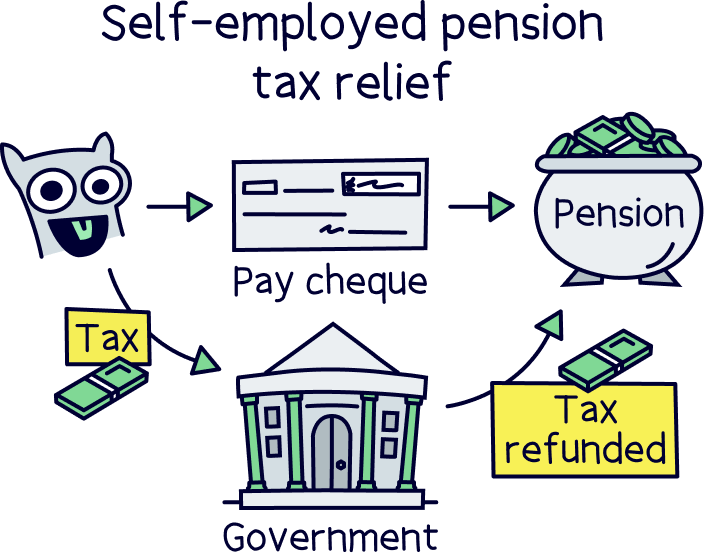
Note: a personal pension and workplace pension are both types of private pension – and often personal pensions are called private pensions.
The main difference is that with a personal pension, you choose the pension provider (company), and set up your pension yourself, whereas a workplace pension is set up by your employer. But, they’re both private to you, you decide how much to save, and later on, when you withdraw from it.
There’s also the State Pension, which is the government pension, and is what you’ll get at State Pension age (currently 66), if you make at least 10 years worth of National Insurance contributions, and 35 years for the full amount.
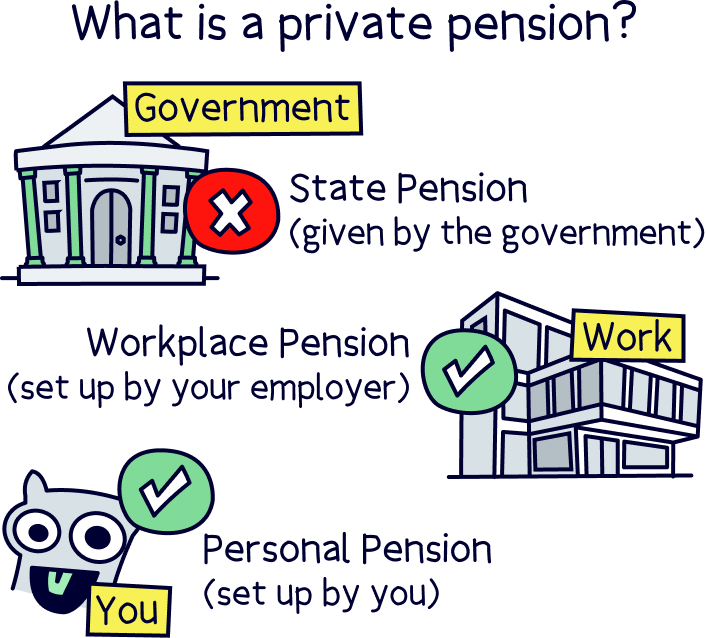
Nuts About Money tip: don’t rely on the State Pension for your retirement. It’s not a lot, just £11,973 per year, and far less below what you’ll likely need in retirement (as much as £43,100 per year). Learn more with our guide to how much you’ll need in your pension pot.
Get ready for some pretty amazing news about personal pensions and tax relief…
When you save money into a personal pension, you’ll get a massive 25% bonus from the government, added directly into your pension pot. Kerching!
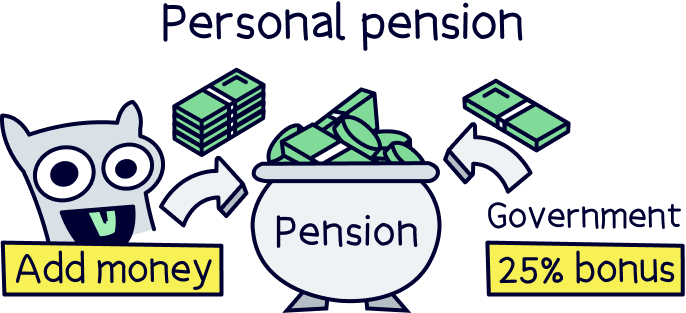
This is the pension tax relief, and it’s to refund you the tax you would have paid (or will pay) on your income, at 20% tax (it sounds odd, but the maths works out). The 20% tax is the basic rate tax relief.
So, for example, if you pay in £80, you’ll get £20 added automatically to your pension pot.
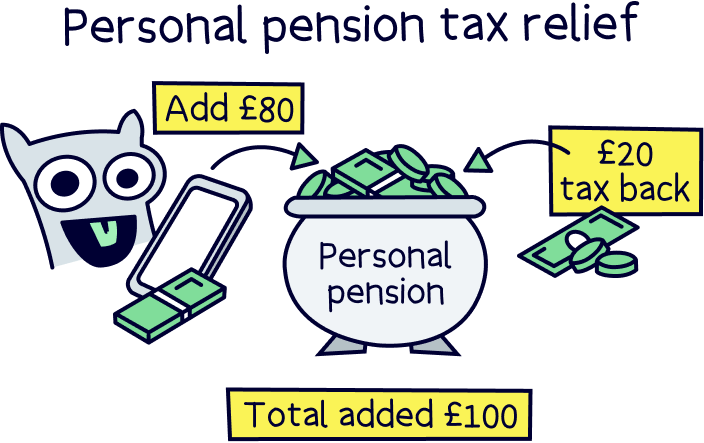
If you’re a higher rate taxpayer (earning over £50,270 per year), and paying 40% tax, or additional rate taxpayer (earning over £125,140 per year), and pay 45% tax, you can claim some of the tax paid at those rates too.
Nuts About Money tip: if you’re keen to get started with a pension already, check out PensionBee¹, it’s easy to use, has low fees and great for those self-employed.
If you do earn more than £50,270 per tax year (April 6th to April 5th the following year), which means you’ll either be paying 40% or 45% tax on your income above this.
When you save into your pension, this tax is taken off first, which means you’ll benefit most from the tax relief (whoop!).
You won’t get it back as a bonus paid into your pension pot (which is called ‘relief at source’), instead, you’ll need to add how much you’ve paid into your pension to your annual Self Assessment tax return, which you might complete yourself, or your accountant will do it for you. This is called ‘relief on making a claim’. If you need help filling in your Self Assessment tax return, chat to Taxfix¹, their service is low cost, quick and 5* rated.
After that, your pension contributions will reduce the amount of tax you’ll need to pay to HMRC. As simple as that.
This type of tax relief only applies to the income you pay Income Tax on (technically called ‘relevant UK earnings’).
So, think of it as your salary (or your sole trader income), rather than any dividends that you have paid yourself (paying profits from a limited company to yourself), or any directors loans you may have lent to yourself.
But, don’t worry, for limited company directors, you get even more tax relief, but it’s a bit different (more below).
PensionBee is the top option. It’s easy to use, low cost and you can pay in from your company too.
Before you get carried away and add lots of money into your pension (although you should!), there are some limits to be aware of.
You can only save as much as your total income (e.g. salary), or up to £60,000, whichever is lower. However, if you are a limited company director, and paying in from your company, your only limit is £60,000 (more on that below).
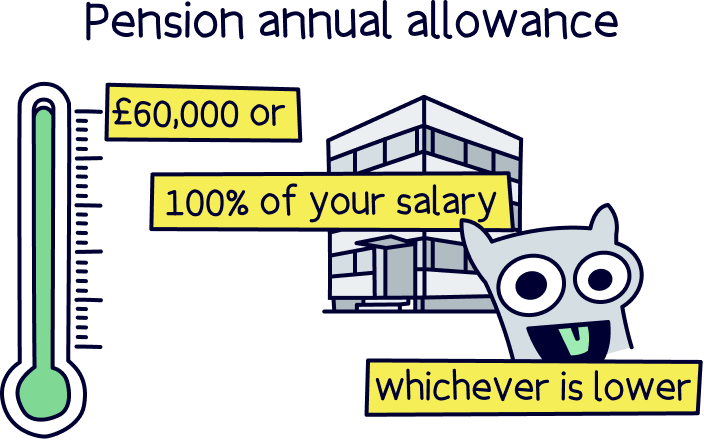
This applies as a total across all of your pensions, so if for instance, you might pay into a workplace pension scheme too, with a job you work part-time at, that counts too.
And typically, if you start withdrawing from your pension (if you’re over 55), your annual allowance reduces to £10,000, which is called the money purchase annual allowance (MPAA).
Note: you can actually pay more if you want to, but you won’t get any tax relief, so it can be worth saving into a Stocks and Shares ISA instead (where your money grows tax-free, and no tax on withdrawals).
You can actually pay more into your pension if you haven’t used the full limit in the previous 3 tax years – so you can pay in up to 3 years worth within one year. This is called ‘pension carry forward’. However, you do need to have had a pension account open during those 3 years.
If you're lucky enough to be a very high earner, earning over £260,000 (via income (e.g. a salary)), your annual allowance (the £60,000) will reduce by £2 for every £1 you earn above £260,000, until you reach £360,000 – so you’ll still have an allowance of £10,000 per year to save into a pension (and claim tax-relief).
If you’re self-employed via your own limited company, you’ll actually get even more tax relief.
That’s because you can pay into your pension directly from your limited company, and doing so counts as a business expense – which reduces the amount of profit your company makes. (This is called employer pension contributions.)
So, your pension contributions can save an extra 19%-25% in tax, depending on how much your company pays in Corporation Tax (tax on business profits).
All your pension contributions will still go into your pension pot tax-free, but there’s no need for the 25% bonus from the government, or to claim back any tax on your Self Assessment tax return, as you pay in directly from your company bank account into your pension pot (so bypass any personal tax).
Pretty great right?
And, you’re not limited by how much your salary is, you can save up to £60,000 per year, regardless of how much you pay yourself. (If you’re a sole trader, you’re limited to the amount you pay yourself.)
There is one thing to be aware of, and that’s that the employer pension contributions need to be reasonable – so if there’s lots of directors, but only one opts for a pension (and a very large one), it might not be reasonable for your business (one director companies are often fine). Or, if you haven’t made a lot of profit.
If tax-relief wasn’t already selling you to get yourself set up with a personal pension, well keep reading, there’s even more benefits.
Aside, from the 25% government bonus, your money will actually grow tax-free too – so it can grow much more over time, and there’s no paperwork to sort each year either (like there is with your Self Assessment).
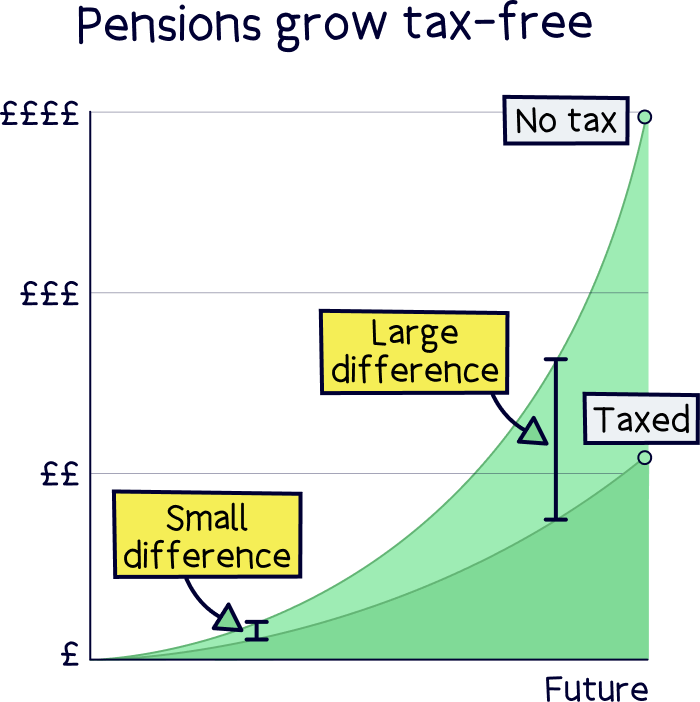
Sorry to put a downer on things, but it’s important to know. When you sadly pass away, your pension is actually completely separate from your estate, which is all of your money and possessions added up.
Your estate counts towards Inheritance Tax, and is typically 40% on anything above £325,000. However, your pension is not included, and if you pass away before the age of 75, whoever you choose to receive your pension, will receive it completely tax-free.
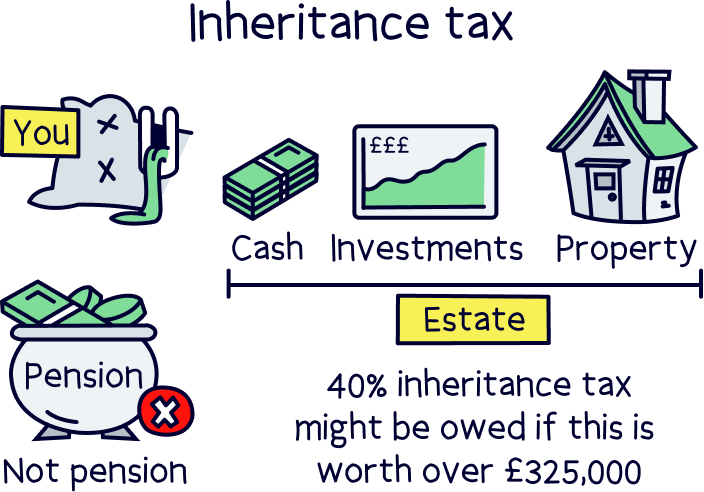
If you pass away over the age of 75, whoever receives your pension may pay Income Tax on it, depending on their income and how much they withdraw.
So, it could act as a form of life insurance for your family.
Pensions are actually pretty great right? Perfect to save for retirement, whilst also reducing your tax bill – it’s a win-win.
Finding the right pension for you, as a self-employed person can be quite difficult however…
But don’t worry, we’ve done the hard work for you. Here’s our top recommendations for both sole traders and limited company directors (where you can pay in from your company bank account).
Great app



A great and easy to use pension. Add money from your bank or combine old pensions into one, (they’ll find lost pensions too).
The customer service is excellent, with support based in the UK.

Beach is an easy to use pension app (and easy to set up), where you just add money and the experts handle everything. It’s all managed on your phone with a great app, and you can see your total pension pot whenever you like.
If you’ve got lost or old pensions, Beach can also find them and move them over too, so you can keep all your retirement savings in one place, and never have to worry about losing them in future.
You’ll get an automatic 25% bonus on the money you add to your pension pot from your bank account (tax relief from the government), which refunds 20% tax on your income, and if you pay 40% or 45% tax, you’ll typically be able to claim the extra back too.
The pension plan (investments) are managed by experts, who are the largest investment company in the world (BlackRock). And they consider things like reducing climate change, meaning your savings could make the world a little better in future too.
You can also save and invest alongside your pension with an easy access pot (access money in around a week), designed for general savings, with the investments managed sensibly by experts too. And money made can be tax-free within an ISA.
Fees: a simple annual fee of up to 0.73% (minimum £3.99 per month).
Minimum deposit: £25
Customer service: excellent
Pros:
Cons:
PensionBee is the top option. It’s easy to use, low cost and you can pay in from your company too.
When you’ve built up a nice big pension pot, all set to retire, as you’ve got a private pension, you’ll be able to start withdrawing it from the age of 55 (57 from 2028). Although it’s often a good idea to keep it saved and invested in your pension so it can keep growing further (if you’re not ready to retire yet).
When you do start to withdraw it, 25% of your pension will be completely tax-free, and you can withdraw this as a tax-free lump sum if you like.
With the remaining 75%, you’ll likely pay Income Tax on it, which is the same as your salary now, and the amount you’ll actually pay will depend on your income at the time.
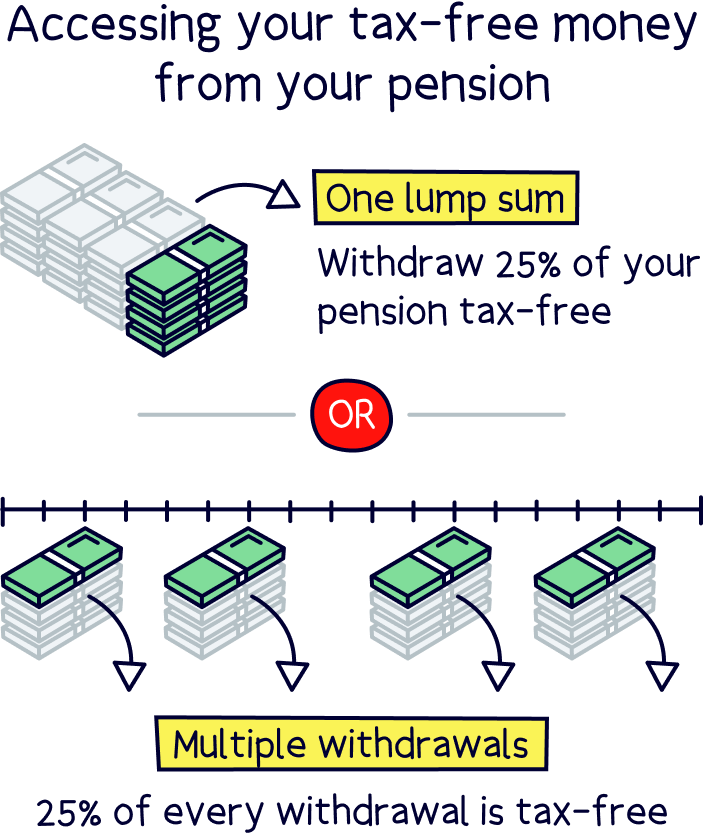
Pensions can be pretty complicated, and that’s before we even get to the tax-relief bit – so we hope this has made things a bit easier to understand.
As you can see, pensions are really great, and as a self-employed person, they’re pretty essential to building a big enough pension pot to actually retire with a good income, when the time comes.
The tax-relief you get is huge, and there’s not much paperwork to claim it. If you open a personal pension, and make contributions from your personal bank account, you’ll automatically get a 25% bonus from the government, added to your pension pot.
If you do pay higher rate tax (40%), or additional rate tax (45%), you can easily claim this back on your Self Assessment tax return (either yourself, or via your accountant).
And, if you’re a limited company director, you can pay in directly from your business bank account and have your pension contributions count as a business expense, and save even more cash on your overall tax bill (by reducing your profit).
Pensions really are the best way to save for your future, and getting started now is the best time to start – it will soon start adding up, and you’ll be on the way to a very bright future.
If you’re not sure where to get started with a self-employed pension, check out PensionBee¹, it’s 5* rated, easy to use, has low fees and you can pay in from a business bank account.
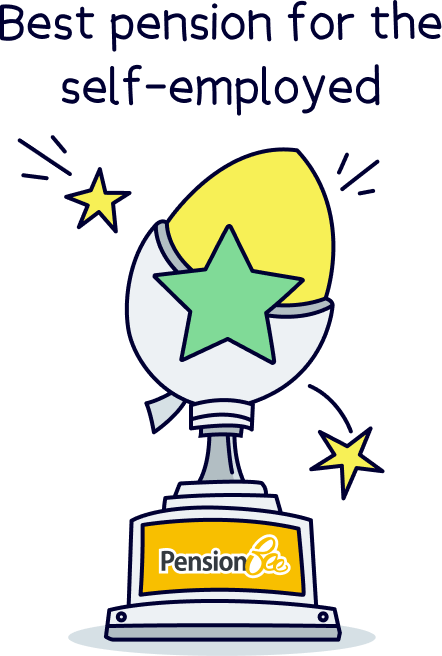
Beach¹ is also great, it's an easy to use pension with a great app. Add money or combine old pensions (and find lost pensions). Plus, the customer service is excellent. Or, for all your options, check out the best pension providers.
That’s it – all the best saving for your future.
PensionBee is the top option. It’s easy to use, low cost and you can pay in from your company too.
PensionBee is the top option. It’s easy to use, low cost and you can pay in from your company too.
We’d love to hear from you, and it will help others too.
PensionBee is the top option. It’s easy to use, low cost and you can pay in from your company too.